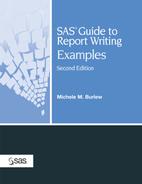Example 2.6. Suppressing the Display of Specific Columns
Goal
List observations in a data set and summarize selected numeric variables. Summarize over all observations and summarize within groups. Summarize specific variables within an observation and add these summaries as columns in the report. Display the summary columns. Do not display the variables used to calculate the summaries.
Report
Regional Energy Quarterly Use by Residential and Commercial |
Example Features
| Data Set | POWERUSE |
| Featured Step | PROC REPORT |
| Featured Step Statements and Options | DEFINE statement: ANALYSIS, COMPUTED, NOPRINT, ORDER, and SUM options
COMPUTE blocks to create new variables BREAK AFTER statement: SUMMARIZE option RBREAK AFTER statement: SUMMARIZE option |
| Formatting Features | Controlling line breaks in column headings
DEFINE statement: WIDTH option when sending output to the LISTING destination. BREAK and RBREAK statements: DOL, DUL, and SKIP options when sending output to the LISTING destination |
| Other Examples That Use This Data Set | Examples 2.4, 2.5, and 6.10 |
Example Overview
This report includes only the summary columns from Example 2.5. It presents energy usage by type of service for commercial and residential customers by quarter. This example sums columns and rows. It suppresses the display of the analysis variables used to compute the quarter totals, which were displayed in Example 2.5.
Each detail row in the report—those with a value for SERVICE—corresponds to one observation in the POWERUSE data set. The other rows, which are summaries of the detail rows, were created by the PROC REPORT statements, BREAK and RBREAK.
The columns for customer group and type of service each correspond to a variable in the POWERUSE data set. PROC REPORT defines the other three columns. It calculates their values with programming statements in COMPUTE blocks. The calculations sum the monthly usage variables in the POWERUSE data set.
Program
Where to Go from Here
PROC REPORT reference and usage information. See “The REPORT Procedure” in the “Procedures” section of Base SAS 9.1 Procedures Guide.
